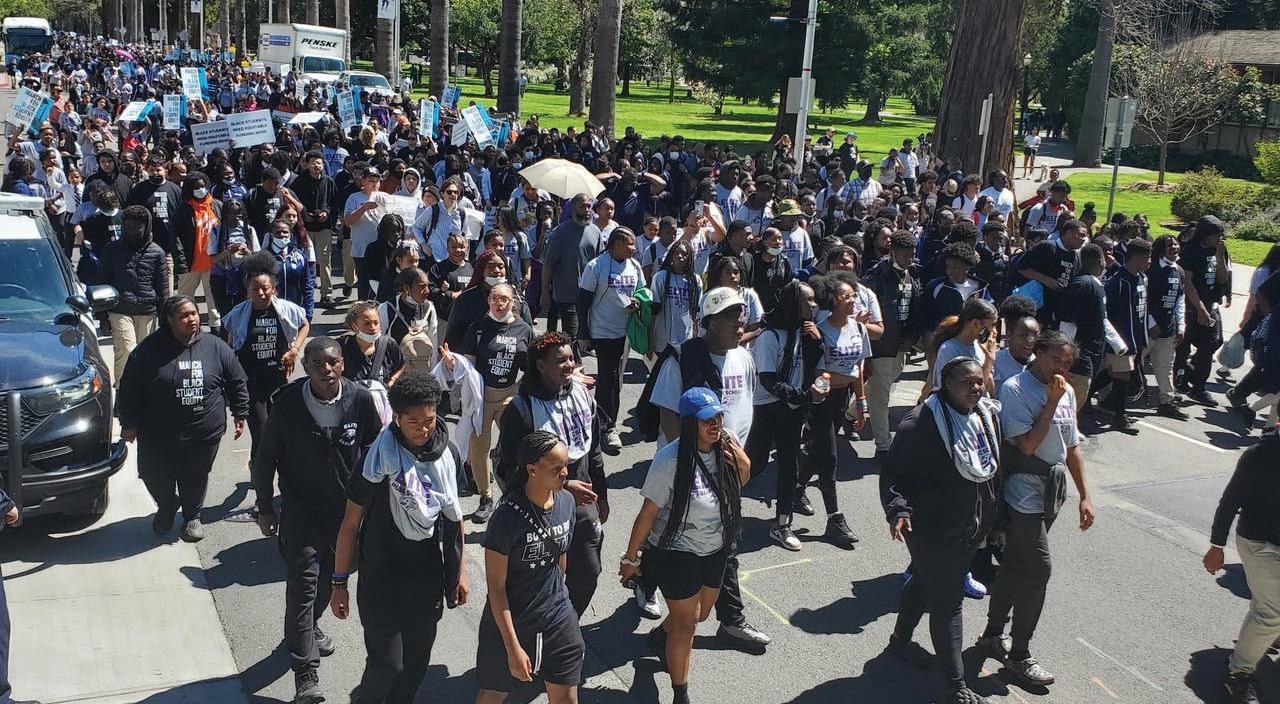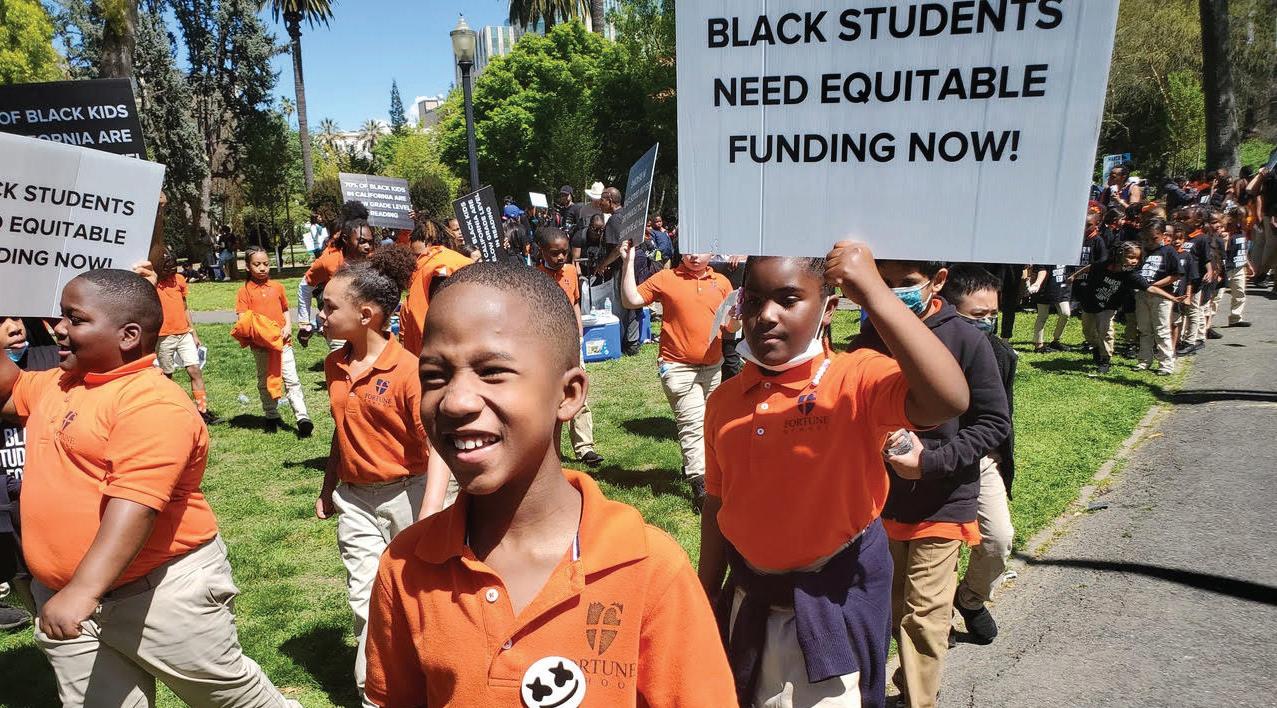
7 minute read
Gov. Newsom and Advocates at Impasse Over Funding for Black Students’ Education
derstood and effective, especially if the goal is to highlight their impacts to funders, customers, and the community. This training offers an opportunity for leaders to learn what storytelling is, provide ways to identify their organization’s stories, and create a dynamic, relevant narrative that grabs the attention of people who need their services, organizations who want to partner with them, and funders ready to invest in their good work.
Participants will also learn how effectively to use powerful tools, such as their website, social media, blogs, ChatGPT, newsletters, and vivid images to increase awareness of an organization’s impact.
“There’s a story being told about who you are and what you do,”
Shepherd says, “The question is, ‘Who’s telling your story?’ This is the essence of this important workshop. All leaders who work within a nonprofit or faith-based organization — you’ll definitely want to attend!”
Learning objectives:
• The importance of telling your own story
Strategies for using the right platforms
• What a website says about your organization (its priorities and impact)
• How to identify the right social media to communicate with key stakeholders
• How blogging can attract collaborative partners and funders
• and more!
Date: April 27, 2023
Time: 9 a.m. – 11 a.m. PST
Location: Virtual training, Zoom
Meeting ID: 861 4945 3331
To Register for the Event: Visit AModelBuiltOnFaith.org
By Joe W. Bowers Jr. California Black Media
Last week, at the invitation of the Black in School Coalition (BISC), over 2,500 K-12 students, parents, education advocates, and civil rights leaders marched to the California State Capitol to demand increased funding for Black students in the state’s public schools.

BISC is a statewide advocacy association consisting of 17 organizations from all parts of the education community, including teachers, administrators, local school districts and county board of education trustees, parents, civil rights, and faith groups.
The BISC marchers were calling on Gov. Gavin Newsom and the California Legislature to not move forward with the “Equity Multiplier” proposed in the governor’s Education Budget, which is supposed to be a substitute for Assembly Bill (AB) 2774 authored by Assemblymember Akilah Weber (D – La Mesa).
AB 2774 would have guaranteed funding for California’s lowest performing group, Black students, but advocates say, Newsom’s proposal falls short of that goal.
Because Newsom raised concerns that targeting funds to a specific group of students would violate Prop 209, which prevents preferential treatment based on race, Weber withdrew AB 2774. In exchange, Newsom agreed to increase funding for Black students under the Local Control Funding Formula (LCFF) in the 2023 budget.
The LCFF is a state law that provides funding to local school districts based on the needs of their students. California’s highest-needs student populations receiving supplemental funding for additional support are English Language Learners, low-income students, and children in foster care or homeless youth. However, despite chronic underperformance, Black students are not identified as a high-needs population for funding.
According to state data, in the 2021-22 academic year, 30% of California’s Black students met English standards and 15% met math standards, compared to 61% and 48% of White students meeting reading and math standards, respectively.
The equity multiplier proposal provides $300 million in ongoing Proposition 98 funding to the LCFF to accelerate gains in closing opportunity and outcome gaps. The funds are allocated to school districts with schools serving high concentrations of students eligible for free meals.
The equity multiplier is part of Newsom’s plan to overhaul how the state can hold districts and schools accountable for student performance, with particular at- low-income schools, BISC has developed an alternative plan to the Equity Multiplier. It proposes additional funding for any group not already funded that scores below the state average on any two metrics on the California School Dashboard. Based on this year’s dashboard results, Black and Native American students would qualify. Because students who have received LCFF funding have shown progress and improved outcomes due to concentrated resources aimed at their improvement, BISC’s funding alternative intentionally provides Black students
By McKenzie Jackson California Black Media
Californians enrolled in MediCal should keep an eye out for a yellow envelope in their mailbox over the next 14 months.
The Medi-Cal eligibility of over 15.4 million Golden State residents is under review for the first time since the onset of the COVID-19 pandemic in March 2020.
If a Medi-Cal beneficiary does receive the yellow envelope, they must provide their current contact information to health care officials as soon as possible to retain their Medi-Cal coverage, noted California Department of Health Care Services (DHCS) Assistant Deputy Director Yingjia Huang.
“It is critical that they do it by the due date that is on the packet that will come,” she said. “If that is not completed by the due date, there is a possibility that you will lose your coverage from MediCal.” by their states’ health department. after getting the packet in the mail. tention to racial disparities. According to Newsom’s office, 95% of Black students in California will be impacted because they are enrolled in districts potentially facing new accountability requirements due to low performance.
According to DHCS figures, 1,066,215 African Americans in California have Medi-Cal. Over 2.6 million whites are enrolled in the program, as are 7.4 million Latinos. Over 2.8 million people who did not provide a race or ethnicity are insured by Medi-Cal and the number of Asian/Pacific Islanders enrolled is over 1.4 million. By ethnicity, people of American Indian/Alaskan Native descent account for the lowest number of enrollees at 55,851.
Children’s Partnership Executive Director Mayra Alvarez said during the online call that it is important for Medi-Cal eligible families to keep coverage.
For example, packets mailed this month have a June 30 due date and packets sent in May must be returned by July 31. The Medi-Cal account holders can provide that info by mail, online, or by calling their county’s Medi-Cal office.
“The easiest way to actually do this is online,” Huang remarked. Medi-Cal members all have different medical renewal months. Around 30% will be automatically renewed. Those people will get a letter in the mail acknowledging that.
Dr. Margaret Fortune, president and CEO of the charter school organization Fortune School of Education and the lead voice for BISC says Newsom’s proposal sounds good but does not reflect the intentions of Weber’s bill.
According to an analysis conducted by EdSource, the funding from Newsom’s proposal would benefit about 6% of Black students statewide and they would be receiving an estimated $18 million out of $300 million proposed. Overall, the proposal targets just 5% of students in the state in about 800 schools and the students reached in those schools are mostly Latino.
To address this disparity in funding for Black students not in the additional support that has benefited high-needs student groups.
Prior to their march on the Capitol, members of the BISC and students provided public comments at the State Assembly’s education budget committee hearing in support of their alternative budget proposal.
Fortune suggested to the committee that the $300 million in the governor’s equity multiplier proposal be directed to student groups who perform below the state average on two or more state indicators on the California school dashboard. This would increase per-student funding from $713 under the governor’s proposal to $3,318 for students in California with the greatest academic needs.
Under the BISC alternative plan, an additional 81,617 Black students and 8,807 Native American students would be eligible for this funding, compared to an additional 22,699 Black students and
Continued on page 9
Huang was one of several speakers featured during an April 12 online media briefing held to notify Medi-Cal members of the health coverage eligibility check, which began on April 1. The media teleconference was organized by California Black Media and Ethnic Media Services in partnership with DHCS.
Medi-Cal is California’s version of Medicaid, the federal government-funded health insurance program. Administered in conjunction with states, Medicaid is designed for people with limited incomes. The insurance covers services such as dental care, prescriptions, and medical and preventive care.
The Families First Coronavirus Response Act, enacted in 2020, directed Medicaid programs nationally to keep everyone enrolled during the pandemic. The annual redetermination process was suspended due to the severity of the worldwide health emergency. However, federal agencies declared the emergency over last month. So now, 80 million Americans are in the process of having their Medicaid eligibility checked
“As we come out of this public health emergency, health insurance coverage and access to care is essential for everyone to be healthy and thrive,” she explained. “Particularly during this pandemic, which has also exacerbated mental health issues for children and youth across the state.”
Alvarez said most of MediCal enrollees are people of color, and nearly 70% of the 5.7 million children that use the service are minorities.
“It is a lifeline for so many in our communities, and it’s a program that continues to be available for the millions enrolled,” she stated. “Even before the pandemic, long standing, structurally racist policies and practices have created an environment wherein families of color experience significantly greater degrees of instability. Instability in employment; instability in income; instability in housing. These economic and housing conditions actually heighten the risk of disruptions in health coverage and in doing so, eliminates the security that comes with having health insurance coverage.”
The packets inside the yellow envelopes Medi-Cal members will receive ask for personal information, including their current phone number, email address, and street address. Recipients must reply by the deadline, which is typically between 45 to 60 days
Also, addressed during the briefing were the steps involved in redetermining a person’s eligibility and how to get information in 19 different languages.
Between two million to three million Californians will lose the health service, while others will become eligible for the first time.
Workers hired to jobs that provide health benefits and people who earn enough income to be shifted from the health coverage to Covered California, the state’s health insurance exchange, are among those predicted to lose Medi-Cal.
Huang said the switch from Medi-Cal to Covered California can be automatic.
“It all goes back to the member must have the most updated information with the county Medi-Cal office for that process to happen,” she said.
The Medi-Cal packets are sent to the last known address of beneficiaries. Recipients whose name, phone number, email address or mailing address have changed in the last three years need to update that information at Covered California, BenefitsCal, or My Benefits CalWIN.

Medi-Cal coverage, Alvarez said, can continue for everyone who is eligible.
“Now is the time to make sure we are taking the necessary steps to keep our coverage,” she noted.
“This is especially important for people of color, who are more likely to rely on Medi-Cal for coverage and who are more likely to be at risk of losing that coverage.”










